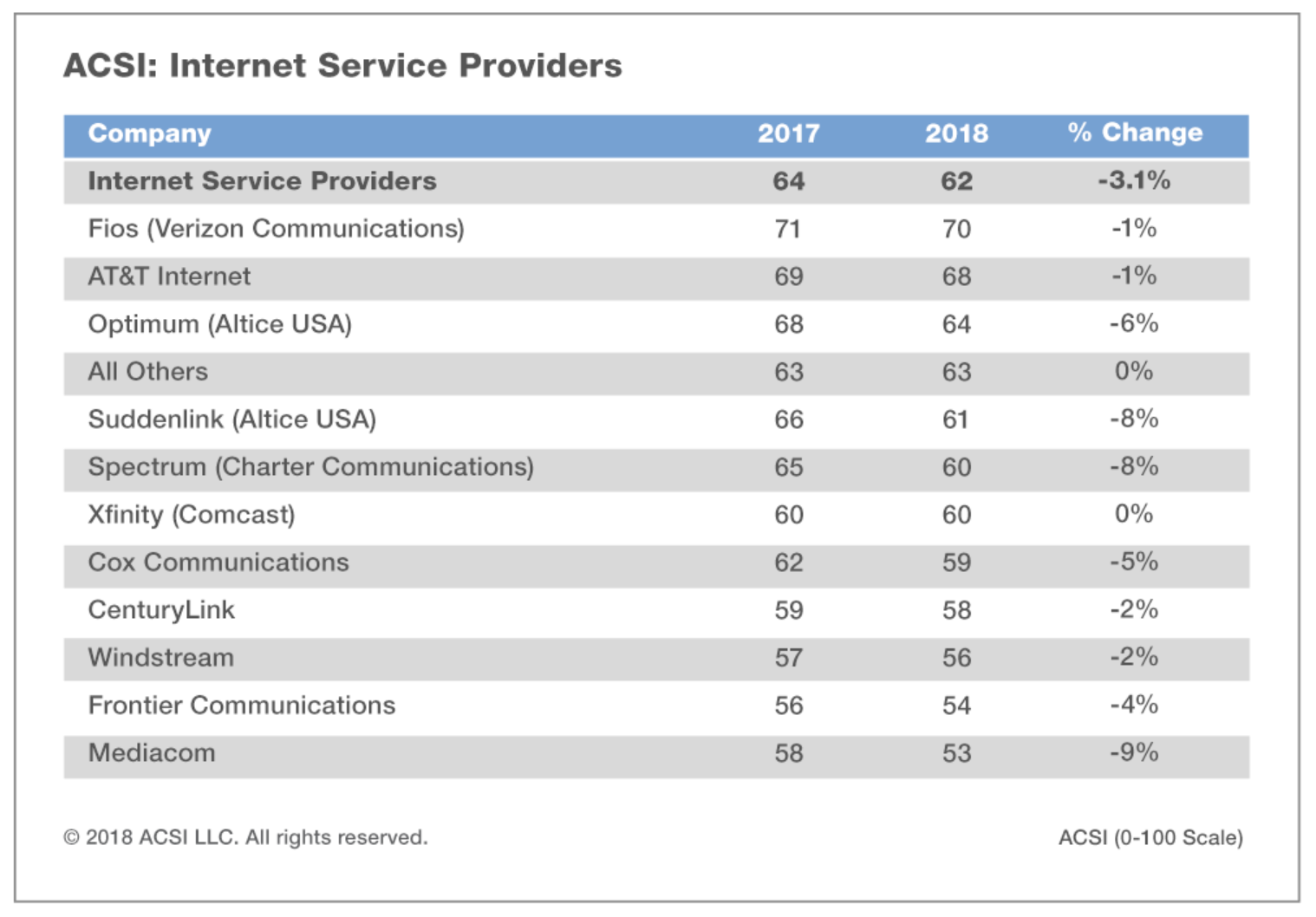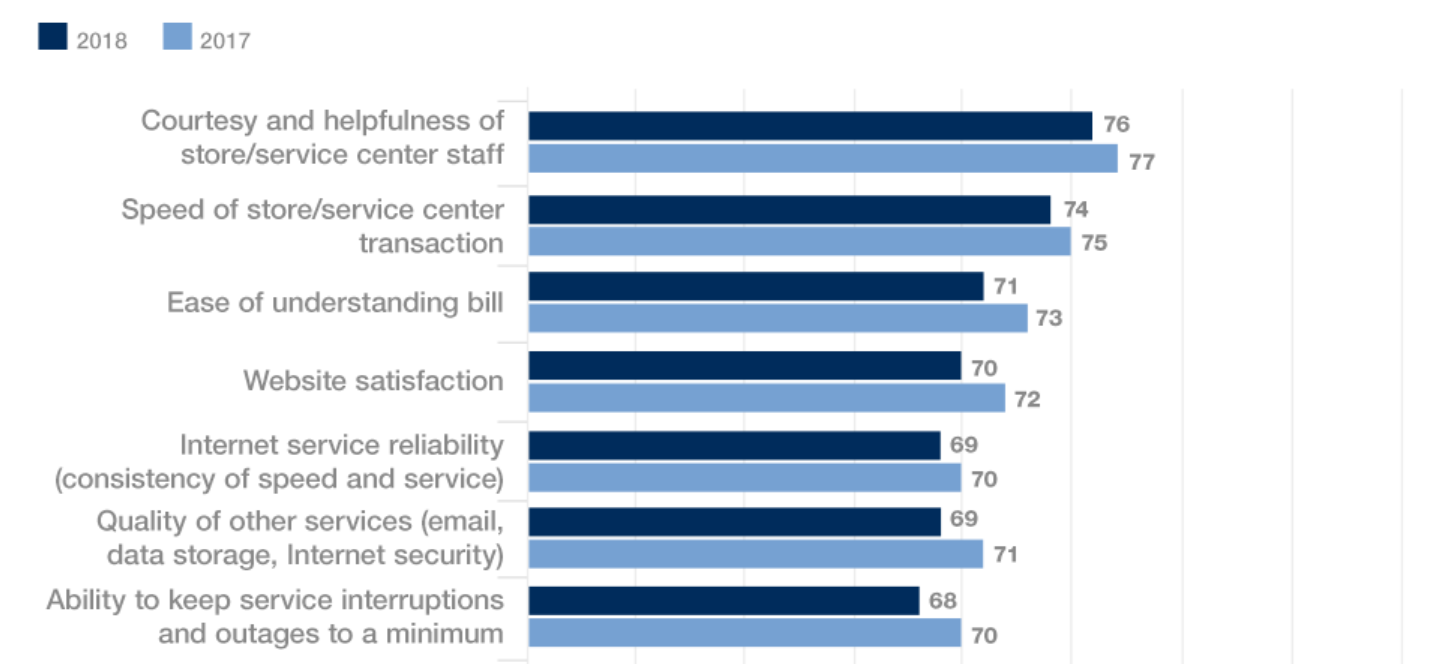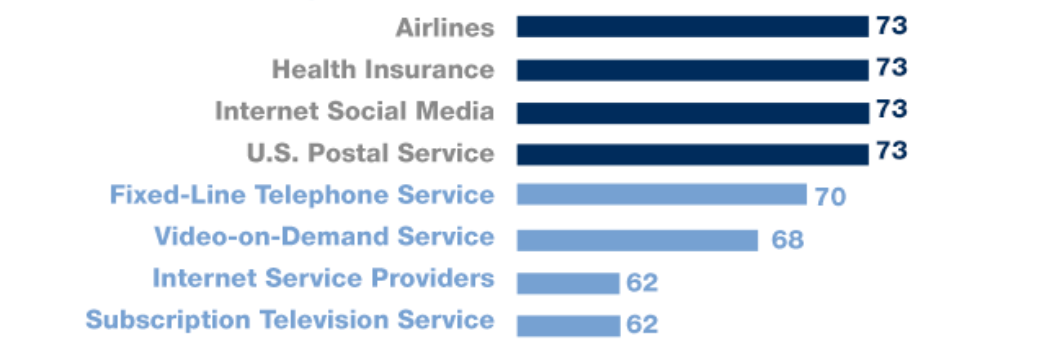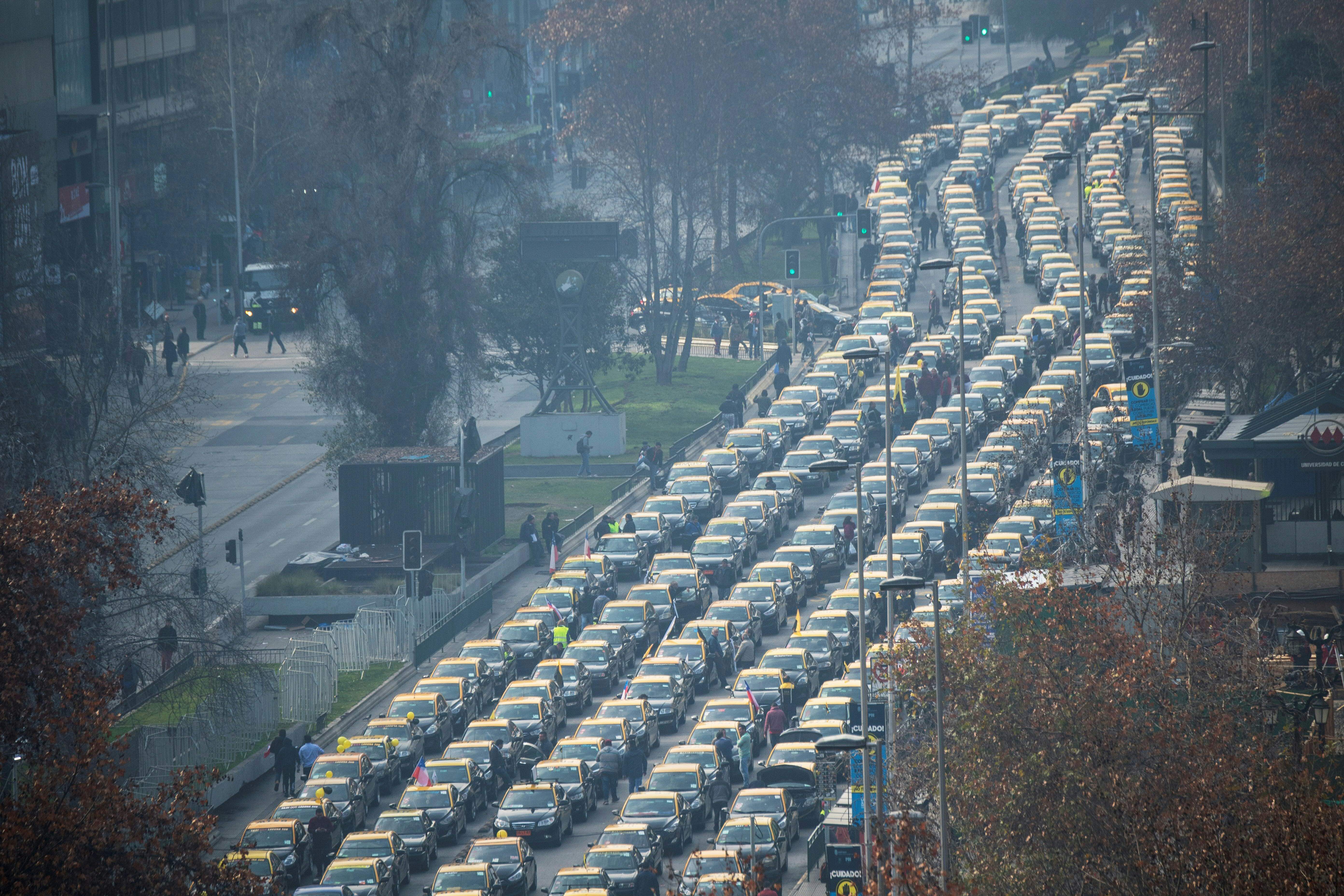Music
Trailers
DailyVideos
India
Pakistan
Afghanistan
Bangladesh
Srilanka
Nepal
Thailand
Iraq
Iran
Russia
Brazil
StockMarket
Business
CryptoCurrency
Technology
Startup
Trending Videos
Coupons
Football
Search
Download App in Playstore
Download App
Best Collections
Technology


Cyrillic is an ancient script dating back more than 1,000 years with the earliest form of the alphabet emerging in Bulgaria in the 9th Century.
But some Bulgarians have found their Twitter accounts suspended and tweets hidden because they are thought to be the work of Russian bots, as Russian also uses the Cyrillic
- Details
- Category: Technology
Read more: Bulgarians tweeting in Cyrillic confused for Russian bots
Write comment (92 Comments)Disliking oneinternet provider is such a common condition that ithard to imagine that ISPs have anywhere to go but up in the eyes of their customers. Nope! There are new lows ahead, if the latest American Customer Satisfaction Index is any indication. Charts ahead!
The ACSI compiles thousands of interviews with consumers and produce a score for various companies and industries based on a number of metrics. And this year, internet providers fell from last place to last place minus.

(Note: Verizon owns Oath, which owns TechCrunch. Believe me, it doesn&t affect our coverage.)
&An all-time low for the industry that along with subscription TV already had the poorest customer satisfaction among all industries tracked by the ACSI,& the report reads. &Customers are unhappy with the high price of poor service, but many households have limited alternatives as more than half of all Americans have only one choice for high speed broadband.&
Despite what the FCC and broadband companies like to say, few people have more than one good choice for internet provider, unlike even other industries that are dominated by a handful of companies, like mobile. And the service people do have access to isn&t inspiring loyalty.
Pretty much every category saw a drop, despite ardent promises from the likes of Comcast and Cox to improve their customer service and simplify bills and offers.

A sample of ratings the ISPs received & dark blue is the latest.
I myself actually just had a good interaction with Comcast, but because it was just a nice customer service agent helping me navigate the companylabyrinth of misleading offers and upsells, I consider it as breaking even. Or it would have if my bill hadn&t just nearly doubled without any notification, so in the end itprobably a negative.
Streaming services and video on demand were included in the survey for the first time this year, and did fairly well. Netflix, PlayStation Vue and Twitch were well thought of, and even the worst-ranked service, SonyCrackle, beats most of the perennially disliked pay TV providers. Strangely enough, most of the latter are the very same providers are often the same as the perennially disliked broadband providers. Coincidence You be the judge.

Worse than social media These days thatquite a feat.
Overall, those companies are at the very bottom of the list, below even airlines and insurance companies — and ironically, the TVs that are used to watch the content are at the very top of the heap. Time to step up your game, ISPs.
- Details
- Category: Technology
Read more: Customer opinions of ISPs somehow drop even lower
Write comment (94 Comments)Letflash back to the Machine Age, the period in American history that gave us the assembly line, the first nonstop transcontinental flight, regular radio broadcasts, and the first robot capable of performing more than 20 movements. These technological advancements inspired a style of art called Precisionism, popularized by big names like GeorgiaO&Keefe, Charles Sheeler and Charles Demuth.
The Cult of the Machine exhibit at the de Young museum in San Francisco is a reflection of attitudes toward machines and robotics during the Machine Age, the period between the two world wars during which industrial efficiency was the reigning mantra. In an era where efficiency was seen as both beautiful and as a threat, there was an influx of art inspired by anxieties people had about the rise of industrial technology. The exhibit rehashes the &are machines a friend or foe to humans& debate through a Precisionist lens with a thorough, possibly too thorough, collection.
Curated by Emma Acker, the exhibit is predominantly Precisionist works. Precisionism is an early 20th century American modernist style that was born from artists who synthesized European cubism and futurism with the American vision of industrial, urban themes. We see smokestacks, factories, bridges and skyscrapers painted with geometric, smooth techniques.
Technologists today have expressed concern about the takeover of robotics, decline in manufacturing jobs, losing control to AIs, biased algorithms and the loss of craftsmanship to machines. Every tech company has a strategy around machine learning and AI. Venture capitalists are investing in robotics startups. There are robots designed to make pizzas. Robots that autonomously deliver goodsthrough the last mile. Autonomous vehicles designed to replace drivers and flying cars on the horizon. Tech continues to make our world more efficient and convenient, but itimpossible to predict whether machines will eventually help or hinder us as a species. When strolling through the Cult of the Machine exhibit at the de Young, one starts to wonder if this line of questioning will ever end.
Duality of machines as light and dark
The de Young collection is a balance between the anxieties Americans felt toward technology during the Machine Age, mixed with the hope that technology brought to a more connected, convenient world. One gallery dives into menacing interpretations of what technology meant during the period. Charles Sheeler&Suspended Power,& a 1939 oil on canvas depicts a large machine hanging over a few small humans in a factory — a stark representation of the immense, barely-controlled power technology can exert over humanity — and how with one mis-engineered piece, we could be crushed. The piece is the star of the exhibit, encapsulating the looming, unquantifiable threat of the future.
Artists certainly saw the darkness in Americaworship of industry. Take Charles Demuth&s, &Incense of a New Church,& 1921. Here a factory is compared to a church, smoke to incense.
Much of the exhibit is scenes of factories, smokestacks and urban landscapes void of humans, movement and color. The pieces themselves look like they were painted by machines, with no brush strokes to be detected. It could be the combination of the monotony of this art — the quantity of motionless urban landscapes — that makes parts of the exhibit feel empty and tedious. But that just may be the point.
Clarence Holbrook Carter&War Bride,& closes the exhibit. A bride stands to face her groom, a machine.
The absence of human error evokes anonymity and alienation that exist in a technological world. Therean eerie emptiness to these close up shots of mechanical systems. Yet they are the small pieces that make up our world.
Confusing efficiency with beauty
During the Machine Age, the demand for efficiency became the driving force of the modern era. Its easy to see how efficiency was confused with beauty, rather than seen as the fulfillment of economic needs. Yet artists were finding meaning in the intersection of art, commerce and industry.
&I speak in [the] tongue of my times. The mechanical, the industrial. Anything that works efficiently is beautiful.& & Charles Sheeler.
This exhibit is not by any means beautiful. There is nothing here that one might be inspired to hang on a living room wall.
However, for the first time &artists started to discover beauty and meaning in our American fabric of industry and production and elevated it to the level of fine art,& says Acker. &The ideas and themes explored in the works from this period seem to resonate so much with our current moment. Thatwhat I wanted to emphasize. Precisionism was the springboard for thinking about larger themes around our relationship to technology during the Machine Age and today. And how the excitements and anxieties Americans experienced around tech innovation are reflected in our same social forces today.&
Conflict between humans and machines
Perhaps the most interesting part of the exhibit is an interactive feature that invites visitors to select three words out of 30 to express what technology means to them. Some of the options are: creative, interconnected, revolutionary, automated, isolating, surveillance, collaborative, addicting, alienating, cold.At the end of the exhibit the most frequently-selected words are displayed in a collective word portrait.
The word cloud is updated every three seconds, and is contrasted with another word cloud. The other is a composite of Machine Age terms describing technology, drawn from 1920s-1930s American periodicals. Size and color of the words is determined by how frequently it appeared in the texts. It seems the visitors of this exhibit have more optimistic views of tech than the media during the Machine Age did.
Overall the exhibit connects two views of technology: a cult-like promise of a better engineered world, and the crushing fear of the unknown threatening humanitylivelihood.
Where does this leave us now&We can relate to [the Machine Age] now as we enter this 4th industrial revolution. We&re looking forward with excitement and some trepidation toward disruption, displacement and changes on the horizon,& says Acker.
Cult of the Machine: Precisionsim and American Art runs throughAugust 12, 2018 at the de Young Museum in San Francisco. For those interested in exploring how tech has shaped art throughout American history, this exhibit is one to see.
- Details
- Category: Technology
Read more: Review: Cult of the Machine at the de Young
Write comment (92 Comments)While Facebook and Cambridge Analytica are hogging the spotlight, data brokers that collect your information from hundreds of sources and sell it wholesale are laughing all the way to the bank. But they&re not laughing in Vermont, where a first-of-its-kind law hems in these dangerous data mongers and gives the statecitizens much-needed protections.
Data brokers in Vermont will now have to register as such with the state; they must take standard security measures and notify authorities of security breaches (no, they weren&t before); and using their data for criminal purposes like fraud is now its own actionable offense.
If you&re not familiar with data brokers, well, thatthe idea. These companies don&t really have a consumer-facing side, instead opting to collect information on people from as many sources as possible, buying and selling it amongst themselves like the commodity it has become.
This data exists in a regulatory near-vacuum. As long as they step carefully, data brokers can maintain what amounts to a shadow profile on consumers. I talked with director of the World Privacy Forum, Pam Dixon, about this practice.
&If you use an actual credit score, itregulated under the Fair Credit Reporting Act,& she told me. &But if you take a thousand points like shopping habits, zip code, housing status, you can create a new credit score; you can use that and itnot discrimination.&
And while medical data like blood tests are protected from snooping, itnot against the law for a company to make an educated guess your condition from the medicine you pay for at the local pharmacy. Now you&re on a secret list of &inferred& diabetics, and that data gets sold to, for example, Facebook, which combines it with its own metrics and allows advertisers to target it.
Oh yes, Facebook does that. Or did do it for years, only ending the practice under the present scrutiny. &When you looked at Facebooktargeting there were like 90 targets & race, income, housing status — that was all Acxiom data,& Dixon told me; Acxiom is one of the largest brokers.
Data brokers have been quietly supplying everyone with your personal information for a long time. And advertising is the least of its applications: this data is used for informing shadow credit scores, restricting services and offers to certain classes of people, setting terms of loans, and more.
Vermontnew law, which took effect late last week, is the nationfirst to address the data broker problem directly.
&Itbeen a huge oversight,& said Dixon. &Until Vermont passed this law there was no regulation for data brokers. Itthat serious. We&ve been looking for something like this to be put in place for like 20 years.&
Europe, meanwhile, has leapfrogged American regulators with the monumental GDPR, which just entered into effect.
The issue, she said, has always been defining a data broker. Itharder than you might think, considering how secretive and influential these companies are. When every company collects data on their customers and occasionally monetizes it, whoto say where an ordinary business ends and data brokering begins
They fought previous laws, and they fought this one. But Dixon, who along with the companies themselves was part of the statehearings to create the law, said Vermont avoided this pitfall.
&The way the bill is written is extremely well thought through. They didn&t worry as much about the definition, but focused on the activity,& she explained. And indeed the directness and clarity of the law are a pleasant surprise:
While data brokers offer many benefits, there are also risks associated with the widespread aggregation and sale of data about consumers, including risks related to consumers& ability to know and control information held and sold about them and risks arising from the unauthorized or harmful acquisition and use of consumer information.
Consumers may not be aware that data brokers exist, who the companies are, or what information they collect, and may not be aware of available recourse.
This straightforward description of a subtle and widespread problem greatly enabled by technology is a rarity in a world dominated by legislators and judges who regularly demonstrate ignorance on high-tech topics. (You can read the full law here.)
As Dixon pointed out, lots of companies will find themselves encompassed by the lawbroad definition:
&Data broker& means a business, or unit or units of a business, separately or together, that knowingly collects and sells or licenses to third parties the brokered personal information of a consumer with whom the business does not have a direct relationship.
In other words, anyone who collects data second hand and resells it. There are a few exceptions for things like consumer-focused information services (411, for example) but it seems unlikely that any of the real brokers will escape the designation.
With the requirement to register, along with a few other disclosures brokers will be required to make, consumers will be aware of which they can opt out of and how. And if they find themselves the victim of a crime that used broker data — a home loan rate secretly raised because of race, for instance, or a job offer rescinded because of a surreptitiously discovered medical condition — they have legal recourse.
Security at these companies will have to meet a minimum standard, as well as access controls. And data breach rules mean prompt notification if personal data is leaked in spite of them.
Ita good first step and one that should prove extremely beneficial to Vermonters; if itas successful as Dixon thinks it is, other states may soon imitate it.
- Details
- Category: Technology
Read more: Vermont passes first first law to crack down on data brokers
Write comment (93 Comments)One month ago, Yonathan Segovia, a Cabify driver originally from Venezuela, was allegedly attacked by a mob of taxi drivers on the streets of Quito in Ecuador.
In the video that documents the aftermath of his alleged assault, a short-of-breath Segovia narrates to his cell phone what happened. Behind him stand a few traffic police and a contingent of semi-formally dressed taxi drivers donning sunglasses and gesticulating to the police. Segovia directs the camera to the broken windshield and claims that he and his vehicle were attacked by xenophobic taxi drivers yelling fuera Cabify (get out Cabify) and regresa a tu país venezolanos (go back to your country, Venezuelans).
Though incidents of violence against drivers of ride-sharing apps are rare in Ecuador, the official taxi syndicaterhetoric has intensified as yellow cabs have become increasingly frustrated by what they perceive as government inaction over the encroachment of Uber and Cabify.
In neighbouring countries such as Colombia and Costa Rica, taxi drivers have attacked ride-sharing app drivers, their cars, and even passengers.
It had only been a few months after Segovia fled Venezuelaviolent streets that one of his brothers was murdered… killed in a case of mistaken identity, according to the young driver. He had come to Quito to escape, and instead found himself in the middle of a pitched battle between local taxi unions and an international ride-sharing company… a battle that had claimed foreign-born Cabify drivers as collateral damage.
Before choosing Ecuador as his new home, Segovia considered a number of countries in the region. To help make his decision he browsed Venezuelan expat groups on Facebook where people exchange information about their experience and ask for help. He considered going to Panama, but was dissuaded by reports of xenophobia against Venezuelans there.
He had about two months of salary saved for the journey and wanted to spend as little as possible on travel. He finally decided on Ecuador primarily because of its proximity and because the country has used the US dollar as its official currency since a financial meltdown in 1999. Having long abandoned his studies to be a civil engineer, Segovia now needed to send money home to help support his family. Earning US dollars represented the safest way to ensure the well-being of his dependents back home.
Segovia took the 2500 kilometer trip overland from Maracay on the Atlantic Coast to Quito. After arriving in the Ecuadorian capital he initially struggled to find work until he was taken on at a car-wash. Claiming to have suffered exploitation and abuse by the owner of the car wash because of his foreign status, Segovia left the car wash and was told by a friend about Cabify and so he signed up for the driver training.
Cabify enabled him to work flexible hours without suffering the type of discrimination he faced at the car wash. &Itlike I&m my own boss,& he says, although a boss that drives himself pretty hard. Most days Yonathan works 16-18 hour days. Thanks to his sacrifice, Yonathan has been able to send money back home to help his family leave Venezuela. No se vive en Venezuela, se sobrevive, (&No-one lives in Venezuela, they only survive.&) Segovia said. Now he has three brothers living in Argentina. All three drive for Uber.

Thousands of taxi drivers, shouting slogans against Uber such as Uber out and Down with piracy brought traffic to a near standstill in Bogota, the capital of Colombia, a city of more than 8 million people, on May 10, 2017. (Photo by Juan Torres/NurPhoto via Getty Images)
Venezuelans are leaving their country in droves, and their plight is propelling the growth of ride-sharing apps across Latin America. Desperate for work, Venezuelans are flocking to neighbouring countries and often finding immediate employment as drivers for US-based Uber and its regional competitor, the Spanish-based Cabify.
Although the relationship between Uber, Cabify, and the Venezuelan diaspora is often mutually beneficial, it also could be easily perceived as exploitative. On the one hand, ride-sharing apps are the saving grace for many desperate migrants, providing a much needed sources of income. On the other hand, the precarious circumstances in which Venezuelans find themselves abroad means that they are incapable of negotiating the conditions of their employment, making them even more vulnerable to the one-sided conditions ride-sharing apps often impose on their drivers.
And the explosion of Venezuelan drivers has added a jingoistic element to the legal and regulatory battles between ride-sharing apps and taxi syndicates, pitting locally-born taxi drivers against foreign-born riding-sharing drivers in confrontations that sometimes become violent.
Venezuela was once a beacon for development in Latin America, which makes its current predicament all the more perplexing. In the 1960s Venezuela shed its military dictatorship and looked forward to becoming a developed country thanks to the discovery of the worldlargest oil reserves beneath Lake Maracaibo. Despite its vast potential, the benefits of Venezuelagrowth did not trickle down to the countrypoorest citizens.

People walk by graffiti with an image of late President Hugo Chavez in Caracas on May 11, 2018. & Venezuelan citizens face a severe socio-economic crisis, with hyperinflation & estimated at 13,800% by the IMF for 2018 & and shortages of food, medicines and other basic products. (Luis ROBAYO / AFP/Getty Images)
In 1999 Lt. Colonel Hugo Chavez, a populist strongman and failed coup-leader, was elected on a mandate to bring socialism to Venezuela by appealing to class divisions. Benefiting from record-high $100/barrel oil prices, Chavez re-directed the countryoil wealth to the poor through a vast array of well meaning but unsustainable government welfare schemes. 14 years into his mandate, Chavez died of cancer in 2013. Shortly thereafter the bottom fell out of the price of oil, plunging to $26/barrel by 2016.
Chavezchosen successor, the former bus driver and union leader Nicolas Maduro, was elected in a contested vote in 2014. As oil wealth dried up, Venezuelans became aware of how years of socialist policies, including expropriations, had damaged the countrynon-oil productive capacity, making them over-reliant on imports and increasingly short of foreign exchange.
Rather than attempt to mend for errors past, Maduro doubled-down on socialism and oppression by attacking the media, violently suppressing protests, throwing his opponents in jail, and creating a parallel congress after voters gave a majority to an opposition coalition in 2015. From there Venezuelanightmare has become increasingly farcical. Two of Maduronephews have been convicted for drug trafficking by the United States. The countrycurrent vice-president was also accused by the United States of drug trafficking, prompting sanctions. Mismanagement has driven Venezuelan oil-production to an all-time low. Slowly, the country is running out of cash. Inequality, the cornerstone issue for the self-nominated Bolivarian socialists, is actually worse than ever.
Ithard to overstate the scale of the humanitarian, economic, political and social crisis that causes Venezuelans to leave. Food shortages are rife. Medicines are scarce. Inflation is expected to rise to 13,000% in 2018. Venezuelaelections, including those held this month, are shambolic. Tropical diseases such as malaria that were controlled or eliminated in the 1960s are roaring back. According to the World Economic Forum, Venezuela was the sixth most dangerous country on the planet in 2017.
Leaving Venezuela is increasingly difficult. Airlines such as United, Delta, and regional heavyweight Avianca have suspended flights to Venezuela due to accumulating debts with the foreign-currency-strapped government. Many try to escape to neighbouring caribbean nations by boat, often with dire consequences.
Though precise numbers are difficult to obtain, we know that roughly a million Venezuelans have left the country in the past two years. While some will migrate to the United States, the vast majority will flee overland to neighbouring countries. Colombia alone has registered at least half-a-million legal migrants, while Brazil receives 800 migrants a day.
Often arriving without money or shelter, Venezuelan migrants depend on the networks of friends and family already established in their destination countries to find work. Through Mercosur, a regional trade block that includes most of the countries in South America, Venezuelans are usually able to qualify for working visas, though many work illegally because the costs of getting a visa are prohibitive. Whereas highly-educated Venezuelans have more luck in finding gainful employment, many Venezuelans join the troves of native-born citizens in either the informal economy or under-employment.
![]()
Ride-sharing apps are well-suited to Latin America because most major cities already operate with an extensive network of informal taxis. Cars with hand-made signs that say &taxi& often circulate in dense areas seeking brave passengers while avoiding both formal taxis and the police. Users are attracted to ride-sharing apps because of the additional security and the attention to detail in the quality of service. Whereas traditional taxis are looked upon suspiciously, Uber and Cabify allow for both traceability, on-demand services, and predictable prices, providing a safe and dependable mode of transport where there often isn&t any.
Both Uber and Cabify have focused aggressively on Latin America where the stakes are high. Two cities in Brazil, Rio de Janeiro and São Paulo, represent Uberbiggest markets in terms of rides. Aside from Spain and Portugal, Cabify focuses exclusively on its operations in 12 Latin American countries. Chinese competitor Didi recently purchased Brazilian competitor 99 and promptly launched its first foreign operation in Mexico.
According to Uber, the company has more than 36 million active users in the region and provides employment for more than a million drivers. Cabify, on the other hand, claims to have 13 million users and to have grown its installed-base by 500% between 2016 and 2017.
As reported in TechCrunch, Cabifyparent-company Maxi Mobility recently raised $160 million at a $1.4 billion USD valuation. Maxi MobilitySeries E comes just as Uber sold its east-asia operation to rival Grab, prompting CEO Dara Khosrowshah to disclose that the company is less focused on M-A and more focused on organic growth, thus encouraging the flush-with-cash Maxi MobilityLatin America push. Seeking scale, Maxi Mobility also acquired regional competitor EasyTaxi.
Though their business models are similar there are notable differences between how the two companies operate. Whereas Uber tends to invoice from abroad and thus avoid paying most local taxes, Cabify prefers to setup local entities and thus subject itself to local tax and regulatory regimes where possible. While Uber burns through cash, Cabify flirts with profitability.
The legal hurdles for ride-sharing apps in Latin America are similar to elsewhere in the world. Countries such as Mexico, Panama, and Uruguay have regulated ride-sharing apps. Others such as Argentina, have banned the apps& operations. In most countries in Latin America, including large markets such as Brazil and Colombia, the apps find themselves in legal limbo as cases involving the companies make their way through the arduous and often politicized court systems.

Chilean taxi drivers demonstrate along Alameda Avenue against US on-demand ride service giant Uber, in Santiago, on July 10, 2017./ AFP PHOTO / Martin BERNETTI/Getty Images)
Though Uber was unable to disclose how many of its drivers in Latin America are Venezuelan expats, Cabify acknowledged that in Panama up to 60% of its drivers are Venezuelan nationals. In Ecuador and Argentina, the number is reported to be closer to 10%. The number of Venezuelan drivers in Mexico, Colombia, Peru, and Chile was not disclosed by either company. This presence of Venezuelan drivers across the continent has not only been noticed by tech-savvy business travelers with a keen ear for accents and a penchant for small talk. Panama went so far as to pass a law stating that ride-sharing app drivers must be Panamanian citizens.
Both companies acknowledge that they follow local legislation in hiring drivers. Neither company confirmed that they explicitly check immigration status prior to hiring a driver; however, they do require a local license which in turn requires a valid visa to obtain. Uber and Cabify require drivers submit an up-to-date police record from their country of residence, but not from the drivers& previous countries of residence or countries of origin. Unless local legislation mandates limited hours, Uber and Cabify only sparingly limit the amount of time a driver can work, meaning drivers can work as much or as little as they like. Because of the informal nature of their work, drivers are not covered by national health insurance policies.
Because Venezuelans drivers are often new arrivals without credit history or savings, most negotiate agreements with vehicle owners who manage the relationship with the ride-sharing app. Vehicle owners like to keep their cars operating at close to maximum capacity in order to extract maximum value. Some will juggle as many as three drivers at a time in order to keep their vehicles in constant operation.
In markets where drivers are scarce it is common for drivers to negotiate 50/50 or 40/60 (40% for the driver, 60% for the owner) minus expenses including gasoline and insurance. While Cabify and Uber approve and train each driver and reserve the right to remove drivers from their fleet, the owners of the vehicles are responsible for paying the drivers. In an informal poll of drivers, most claimed to earn between $600 and $1000 USD per month, which is twice the minimum wage in many countries in Latin America and comparable to if not more than what taxi drivers make.
The same drivers claimed that they were making more with Uber and Cabify than they were working under the table in mostly service-sector jobs. Most drivers reported working more than 60 hours a week, well beyond the 40 hour work week legislated in most countries.
The Venezuelan drivers I spoke to across numerous countries generally speak well of Uber and Cabify whilst acknowledging their own vulnerable status. Many have stories to tell of vehicle owners that didn&t pay them, that docked their pay unnecessarily, or that were verbally abusive.
Drivers are dependent on vehicle owners to honor their verbal promises and they have no settlement mechanism to mediate disputes either through local governments or through the companies. For drivers who fall out with vehicle owners, their only option is to switch cars. After all, a driver with positive reviews and a clean record is attractive to vehicle owners hoping to maximize their return. None of the drivers I spoke to felt they were in a position to negotiate their working conditions with the ride-sharing apps.
While itnot clear that Uber and Cabify are targeting Venezuelans fleeing the humanitarian crisis that has engulfed their homeland as part of their hiring strategy, it is clear that the companies have benefited immensely from their presence across Latin America, especially in smaller markets such as Panama, Ecuador, and Bolivia. Finding a pool of unemployed, eager and qualified drivers has allowed the companies to scale the supply-side of their business and thus ensure quick pick-up times for passengers, an essential feature for apps to become &sticky&.
As one vehicle owner stated, &Cabify entered the market right at the same time that Venezuelans were coming in higher numbers. The company never would have achieved critical mass [on the supply side] were it not for Venezuelans.& Uber and Cabify also benefit from the drivers& powerlessness: because the alternative to driving for a ride-sharing app is often worse pay without protections, Venezuelan drivers accept the conditions dictated by the companies without protest.
Most of the countries in Latin America that are receiving Venezuelan migrants lack the infrastructure and the know-how to manage a massive influx of newcomers. Because many Latin American economies have large informal sectors, migrants quickly slip into the informal economy where they have neither benefits nor protections such as minimum wage. Uber, Cabify, EasyTaxi, Didi, etc., represent technologies that Latin American consumers have taken to because they offer a superior customer experience when compared to traditional taxi services.
Nonetheless, the status of these companies continues to be tenuous in countries such as Brazil and Colombia, where court cases drag-on slower than rush hour traffic in Sao Paulo or Bogotá. At the same time, politicians are reluctant to create legislation that will legalize ride-sharing apps for fear of upsetting powerful taxi unions. Ride-sharing apps offer a clear solution to an endemic transportation problem found in almost any Latin American city.
In many ways the problem these apps solve is caused by slow-to-change politicians and resistant-to-change taxi unions. Unfortunately, until local governments catch-up in providing legislation that protects drivers - fairly regulates ride-sharing apps., the growth of companies like Uber and Cabify in Latin America will be based partly on innovation, and partly on desperation and will always take place on the border of legality. In the meantime, as Latin American consumers jump into borrowed cars itworth remembering an adopted adage: there is no such thing as a free ride.
- Details
- Category: Technology
At some point in the future, while riding along in a car, a kid may ask their parent about a distant time in the past when people used steering wheels and pedals to control an automobile. Of course, the full realization of the &auto& part of the word — in the form of fully autonomous automobiles — is a long way off, but there are nonetheless companies trying to build that future today.
However, changing the face of transportation is a costly business, one that typically requires corporate backing or a lot of venture funding to realize such an ambitious goal. A recent funding round, some$128 million raised in a Series A roundby Shenzhen-basedRoadstar.ai, got us atCrunchbase Newsaskinga question: Just how many independent, well-funded autonomous vehicles startups are out there
In short, not as many as you&d think. To investigate further, we took a look atthe set of independent companiesin Crunchbase&autonomous vehicle& category that have raised $50 million or more in venture funding. After a little bit of hand filtering, we found that the companies mostly shook out into two broad categories: those working on sensor technologies, which are integral to any self-driving system, and more &full-stack& hardware and software companies, which incorporate sensors, machine-learned software models and control mechanics into more integrated autonomous systems.
Full-stack self-driving vehicle companies
Letstart with full-stack companies first. The table below shows the set of independent full-stack autonomous vehicle companies operating in the market today, as well as their focus areas, headquarterlocation and the total amount of venture funding raised:
Note the breakdown in focus area between the companies listed above. In general, these companies are focused on building more generalized technology platforms — perhaps to sell or license to major automakers in the future — whereas others intend to own not just the autonomous car technology, but deploy it in a fleet of on-demand taxi and other transportation services.
Making the eyes and ears of autonomous vehicles
On the sensor side, there is also a trend, one thatdecidedly more concentrated on one area of focus, as you&ll be able to discern from the table below:
Some of the most well-funded startups in the sensing field are developing light detection and ranging (LiDAR) technologies, which basically serve as the depth-perceiving &eyes& of autonomous vehicle systems.CYNGNintegrates a number of different sensors, LiDAR included, into its hardware arrays and software tools, which isone heck of a pivotfor the mobile phone OS-maker formerly known as Cyanogen.
But there are other problem spaces for these sensor companies, includingNauto&ssmart dashcam, which gathers location data and detects distracted driving, orAutotalks&sDSRCtechnology for vehicle-to-vehicle communication. (Back in April,Crunchbase News coveredthe $5 million Series A round closed byComma, which released an open-source dashcam app.)
And unlike some of the full-stack providers mentioned earlier, many of these sensor companies have established vendor relationships with the automotive industry.Quanergy Systems, for example, counts components giant Delphi, luxury carmakers Jaguar and Mercedes-Benz and automakers like Hyundai and Renault-Nissan aspartners and investors.Innoviz supplies its solid-state LiDAR technology to the BMW Group, according toits website.
Although radar and even LiDAR are old hat by now, there continues to be innovation in sensors. According to a profile of Oryx VisiontechnologyinIEEE Spectrum, its &coherent optical radar& system is kind of like a hybrid of radar and LiDAR technology in that &it uses a laser to illuminate the road ahead [with infrared light], but like a radar it treats the reflected signal as a wave rather than a particle.& Its technology is able to deliver higher-resolution sensing over a longer distance than traditional radar or newer LiDAR technologies.
Can startups stack up against big corporate competitors
There are plenty of autonomous vehicle initiatives backed by deep corporate pockets. There&sWaymo, a subsidiary of Alphabet, which is subsidized by the huge amount of search profit flung off by Google . Uber has an autonomous vehicles initiative too, although it has encountered a whole host oflegaland safety issues, including holding the unfortunate distinction of beingthe first to kill a pedestrianearlier this year.
Tesla, too, has invested considerable resources into developing assistive technologies for its vehicles, but it too has encountered some roadblocks asits head ofAutopilot(its in-house autonomy solution) left in April. The company also deals with a rash of safety concerns of its own. And although Appleself-driving car program has been less publicized than others, it continues to rollonin the background. Chinese companies like Baidu and Didi Chuxing have alsolaunchedfill-stack R-Dfacilitiesin Silicon Valley.
Traditional automakers have also jumped into the fray. Back in 2016, for the price of a cool $1 billion,General Motors folded Cruise Automation into its R-D effortsin a widely publicized buyout. And, not to be left behind,Ford acquired a majority stakein Argo AI, alsofor $1 billion.
That leaves us with a question: Do even the well-funded startups mentioned earlier stand a chance of either usurping market dominance from corporate incumbents or at least joining their ranks Perhaps.
The reason why so much investor cash is going to these companies is because the market opportunity presented by autonomous vehicle technology is almost comically enormous. Itnot just a matter of the car market itself — projectedto be over 80 million car sales globally in 2018 alone — but how we&ll spend all the time and mental bandwidth freed up by letting computers take the wheel. Itno wonder that so many companies, and their backers, want even a tiny piece of that pie.
- Details
- Category: Technology
Read more: The well-funded startups driven to own the autonomous vehicle stack
Write comment (99 Comments)Page 5253 of 5614

 16
16





